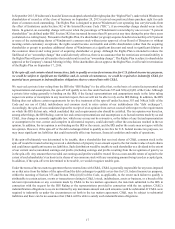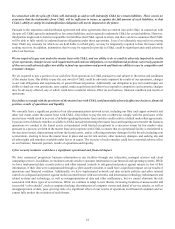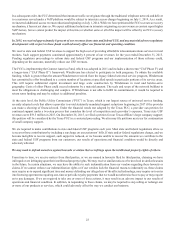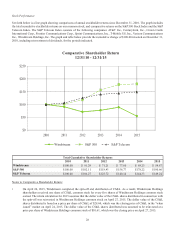Windstream 2015 Annual Report Download - page 103
Download and view the complete annual report
Please find page 103 of the 2015 Windstream annual report below. You can navigate through the pages in the report by either clicking on the pages listed below, or by using the keyword search tool below to find specific information within the annual report.
21
We may not generate sufficient cash flows from operations, or have future borrowings available under our credit facility or from
other sources sufficient to enable us to make our debt payments or to fund dividends and other liquidity needs. We may not be
able to refinance any of our debt, including our credit facility, on commercially reasonable terms or at all. If we are unable to make
payments or refinance our debt, or obtain new financing under these circumstances, we would have to consider other options, such
as selling assets, issuing additional equity or debt, or negotiating with our lenders to restructure the applicable debt. Our credit
agreement and the indentures governing our senior notes may restrict, or market or business conditions may limit, our ability to
do some of these things on favorable terms or at all.
As of February 22, 2016, Moody’s Investors Service (“Moody’s”), S&P and Fitch Ratings (“Fitch”) had granted Windstream the
following senior secured, senior unsecured and corporate credit ratings:
Description Moody’s S&P Fitch
Senior secured credit rating Ba3 BB BBB-
Senior unsecured credit rating B2 B+ BB
Corporate credit rating B1 B+ BB
Outlook Stable Stable Stable
Factors that could affect our short and long-term credit ratings include, but are not limited to, a material decline in our operating
results, increased debt levels relative to operating cash flows resulting from future acquisitions, increased capital expenditure
requirements, or changes to our dividend policy. In addition, we are not currently paying down a significant amount of debt. If
our credit ratings were to be downgraded from current levels, we might incur higher interest costs on future borrowings, and our
access to the public capital markets could be adversely affected.
Tax legislation and administrative initiatives or challenges to our tax positions could adversely affect our results of operations
and financial condition.
We are frequently subject to routine audits by federal, state and local tax authorities. While we believe we have adequately provided
for tax contingencies, these audits may result in tax liabilities that differ materially from what we have recognized in our consolidated
financial statements.
Furthermore, legislators and regulators at all levels of government may from time to time change existing tax rules and regulations
or enact new rules that could negatively impact our operating results and financial condition.
Competition in our consumer service areas could reduce our market share and adversely affect our results of operations and
financial condition.
We face intense competitive pressures in our consumer service areas. If we continue to lose consumer households as we have
historically, our results of operations and financial condition could be adversely affected. During 2015, our consumer households
declined 5.4 percent.
Sources of competition include, but are not limited to, wireless companies, cable television companies and other communications
carriers. Many of our competitors, especially wireless and cable television companies, have advantages over us, including
substantially larger operational and financial resources, larger and more diverse networks, less stringent regulation and superior
brand recognition. For additional discussion regarding competition, see “Competition” in Item 1.
Cable television companies have aggressively expanded in our consumer markets, offering voice and high-speed Internet services
in addition to video services. Some of our customers have chosen to move to cable television providers for their voice, high-speed
Internet and television bundles. Cable television companies are subject to less stringent regulations than our consumer operations.
For more information, refer to the risk factor, “Our competitors, especially cable television companies, in our consumer markets
are subject to less stringent industry regulations.”
Wireless competition has contributed to a reduction in our voice lines and generally has caused pricing pressure in the industry.
Some customers have chosen to stop using traditional wireline phone service and instead rely solely on wireless service. We
anticipate that this trend toward solely using wireless services will continue, particularly if wireless prices continue to decline and
the quality of wireless services improves.
























